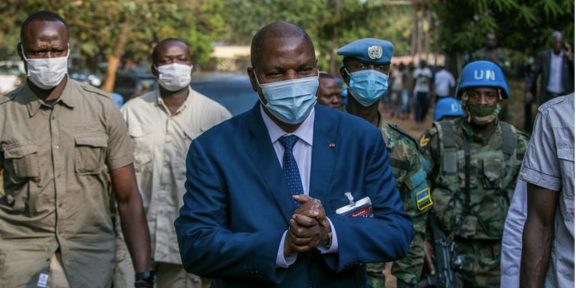Sudan (386 words, 3 minutes, 13 seconds)
The situation in Sudan continues to evolve against the backdrop of a civil war spanning several key fronts. The forces of the Government Army (SAF) and the Rapid Reaction Forces (RDF) continue to actively fight, advancing and changing the balance of power in different regions of the country.
The situation has escalated in the south of Kordofan. The SAF was able to recapture control of Kargal from the Sudan People’s Liberation Movement, which allowed the siege of the city of Dilling to be lifted. As a result of this operation, an important road leading to Kadukli was also opened.
Simultaneously, government forces launched an offensive from the south and north into the Hajar al-Jawada and Kargal districts, which led to the destruction of rebel defenses and the breakthrough of the front. The siege of the city was lifted, and the way to the south was opened for government forces. On the northern front of Kordofan, the SAF continues its offensive against the SBR.
After a series of successful operations, including the liberation of the city of Al-Obeid, government forces are launching an intensified offensive to the east, capturing key settlements such as Al-Hawi and Dankoj. These successes provide the SAF with important strategic positions and weaken enemy resistance.
In the White Nile, the SAF continues to advance, capturing the towns of Al-Kutaina and Saadat Al-Kawahla. It is important to note that this happened in an area that was abandoned by the RB only a few days ago, which demonstrates the continued vulnerability of the rebels in this area.
On the Khartoum front, government forces continued to strengthen their positions, capturing several settlements in the Bahri area, including Al-Marabiya and Umm Ashosh. The loss of the Soba Bridge and the withdrawal of the SSR significantly weakened the rebel positions. In the area of the Republican Palace, SAF forces are approaching the last key points of the enemy’s defense. In addition, a disaster occurred on the outskirts of the Sudanese capital Khartoum: a military plane crashed near the Wadi Saidna airbase, one of the largest military installations of the army in Omdurman.
According to AFP sources, the cause of the crash was a technical malfunction. The crew of the aircraft was killed, and five civilians became victims of the tragedy. The bodies of the dead civilians were taken to Al-Nao Hospital, where there are also several injured. The incident is certainly another tragedy in the context of the ongoing war.
In general, the situation in Sudan continues to change rapidly, as Government forces continue to advance and strengthen their positions on key fronts, despite new challenges and tragic events.
Mali (191 words, 1 minute, 50 seconds)
Over the past week, the Malian Armed Forces have conducted several operations aimed at eliminating terrorism in the region.
On February 21, at 3:10 p.m., a FAMa patrol intercepted a mini-drone equipped with an explosive charge that was shot down in the airspace of the Kidal region, near a military camp. The drone crashed on impact without causing any explosions. Debris and memory cards are being analyzed, and a similar case involving a drone intercepted on February 11 is also being considered.
On February 22, at about 06:25 a.m., a FAMa patrol prevented a terrorist ambush in a densely populated area 12 km northeast of Masina, in the Segou region. Thanks to the rapid coordination of infantry with the support of aviation, the attack was prevented. As a result of the operation, 9 terrorists were killed, and several others were injured and fled into the woods. Motorcycles, weapons and ammunition were also seized. One of the injured soldiers was evacuated to a medical center.
On February 23, at 3:40 p.m., another FAMa patrol engaged in combat with terrorists in the Nyamana area, 23 km northeast of KOLONGO. During the clash, 12 terrorists were eliminated and several weapons, as well as materials for making explosive devices, were seized. Three soldiers were evacuated.
In another communique, it is reported that on the same day, FAMa eliminated 10 terrorists and captured two.
All these operations demonstrate the determination and will to fight terrorism and armed groups in Mali.
Niger (204 words, 1 minute, 55 seconds)
Recent events in and around Niger highlight the increasingly worrying security situation. There have been several attacks that threaten the stability of local communities.
First, a fire was reported in the residence of the French Embassy in Niamey. Although the building is empty and guarded by anti-terrorist forces and the Armed Forces of Niger since the withdrawal of French troops. The fire was localized and eliminated by the evening. The presence of special forces, as well as police, firefighters and gendarmerie, drew attention to the seriousness of the situation.
In the Tilaberi region, the village of Guero Bangiua was the victim of a brutal ISIS attack. After the terrorists took the cattle and burned the houses, they retreated into the forest, leaving behind a destroyed village. These acts of violence are increasingly occurring, exacerbating insecurity in a region where rural communities are becoming increasingly vulnerable.
Later, the villages of Angual Dawora and Doli, located east of Kutumbu, were similarly attacked by ISIS. The attackers arrived on motorcycles, wreaked havoc, took the cattle, and then retreated to Balofolo Hill.
On February 22, the village of Makaani in the Dosso region was the victim of an IS attack, also on motorcycles. The attackers opened fire on the local population, which resulted in numerous human casualties.
On the night of the same day, the Niger-Benin oil pipeline was attacked, between Muntseka and Kamre, at the junction of the Dosso and Tahua regions. The damage from the attack was huge, judging by past attacks on the pipeline, ISIS is behind the attack, although no official statements have been received so far.
These events underscore the seriousness of the security situation, due to the increased frequency and brutality of attacks by terrorist groups that weaken local communities and threaten the stability of the region.
Burkina Faso (130 words, 1 minute, 15 seconds)
The last week in Burkina Faso has been quite intense due to the increased frequency of militant attacks.
The Jamaat Nusrat al-Islam Wal-Muslimin (DNIM) group has become more active. They seized a Burkini militia base in the Kosso area of Muhun province, and then seized a military checkpoint in the Bango area of Wahigui. In the province of Udalan, they clashed with the militants of the Islamic State of the Sahel (IG), killing several people. The militants also carried out an armed attack on Burkini militias in the Tenkodogo area of Bolgu province and attacked a military outpost in Malu, near Kaya, in Bam province.
The militants also carried out several attacks on Burkini military posts near the border with Togo in the province of Kulpelogo. In Solle Mossi, Yatenga Province, they attacked Burkini militias, subsequently killing them. In addition, the group attacked a military checkpoint in Saku, Kongoussi Department, Bam Province.
These increased attacks indicate growing insecurity in the region, where militants continue to attack military and civilian infrastructure.
Nigeria (146 words, 1 minute, 40 seconds)
On February 25, gunmen ambushed the Nigerian army in Goneri, Yobe State, killing several soldiers. The attackers were armed with various types of weapons, including Chinese-made Type 80 machine guns, Romanian PM md. 90 rifles and AKM/S Type 56-1 submachine guns.
In Borno State, the IG group (IG – West Africa) carried out a complex attack on the headquarters of the Red Cross in Monguno. The militants reportedly set fire to 10 vehicles and part of the headquarters, as well as detonated a military vehicle with an explosive device, resulting in casualties among the military.
The group also raided a Christian village in Borno, burning houses, and attacked a Nigerian military camp in the same region. They seized various weapons, including German-made HK21A1 machine guns, Polish-made PG-9V missiles, as well as several other types of firearms and rocket launchers.
In another attack, they captured and killed a member of the Joint Civilian Task Force (CJTF) using a Serbian-made Zastava M21S contraband assault rifle.
Violence continues to take a heavy toll, especially on Christians in Nigeria, where over 62,000 people have been killed by groups such as Boko Haram and ISIS in recent decades, resulting in the destruction of entire villages and the fragmentation of communities.
Ukraine (1339 words, 11-12 minutes)
By February 2025, Russian troops had stepped up their offensive in the Kursk direction, continuing to oust Ukrainian formations from the border territories. One of the key episodes was the liberation of Fanaseevka, where Russian units drove the enemy out of the forest belts and gained a foothold in Cherkassy Konopelka. Meanwhile, fierce fighting continued at the Zhuravka—Sverdlikovo line: Russian assault groups gained a foothold in the northern part of Zhuravka, fighting head-on in the village itself, and also expanded control to the west of Sverdlikovo.
On the eastern flank, the Russian paratroopers launched an offensive in the Lebedevka area, managing to gain a foothold in the northern part of the settlement and moving towards Kazachya Lokni. In the Guevo area, Russian units were based on Plekhovo, but Ukrainian troops pulled in reinforcements, including armored vehicles, which led to violent clashes. At the same time, Russian troops continued to push Ukrainian formations in the direction of the Yunakovka-Sudzha highway, seeking to cut an important logistical artery.
By the end of February, the Russian army had liberated Orlovka, Pogrebki, and Maryevka, and had also advanced north from Viktorovka and Nikolaevka. In addition, soldiers of the 22nd Motorized Rifle brigade attacked from the side of the Olkha ravine and gained a foothold in Novaya Sorochina. Successes were also observed east of the railway, where Russian units drove Ukrainian troops out of ravines in the Kamyshevka and Balki Khitrovsky Yar areas.
In the vicinity of Martynovka, Russian troops cleared the Smerditsa ravine and a number of forest belts near Cherkasskaya Konopelka, but the Lotos gas station still remained in the gray zone. In the west of the Kursk direction, heavy fighting continued in the area of Guevo and Kurilovka, where Ukrainian formations organized dense defenses and systematically counterattacked. Despite stubborn resistance, the Russian army continued to put pressure on enemy supplies: pressure on the Yunakovka-Sudzha highway led to logistical problems for the Ukrainian Armed Forces.
At the same time, against the background of the general weakening of the Ukrainian positions, information appeared about a possible offensive by the Ukrainian Armed Forces in the Bryansk region. Unlike the Kursk and Belgorod regions, large forces of Ukrainian troops have not yet operated here, but the area is densely forested, which makes it convenient for a secretive concentration of groups. According to some reports, the enemy may try to enter the highways leading to Bryansk, capturing large settlements for media effect.
In the current situation, it is logical to assume that the parties will continue fighting in order to achieve the most advantageous positions before possible negotiations. The Ukrainian command is trying to organize counterattacks, but the general position of the front indicates a gradual weakening of their defenses. At the same time, Western media are trying to smooth things over by calling the information about a possible Ukrainian offensive “fake.” However, the practice of war shows that underestimating the enemy can lead to serious consequences, as it has happened before.
Thus, Russian troops have achieved significant success in the Kursk area, liberating a number of settlements and threatening to encircle Ukrainian forces. At the same time, heavy fighting continues, where each new victory comes at the cost of great efforts.
After a slight lull in the Vremyevsky direction, Russian troops resumed active offensive operations. By February 21, they had liberated the settlements of Novoselka and Novocherevatoe, securing the initiative in the Bolshaya Novoselka area. The national flag and the Victory Banner were hoisted in the center of Novocherevaty, confirming full control over the village. At the same time, Russian attack aircraft cleared Novoselka, advancing in the lowlands between settlements, which allowed minimizing losses in open areas.
By February 23, Russian troops had gained a foothold in the forest belts between Novocherevatoye and Razdolnoye, leveling the front line, and also launched attacks on Skudnoye and Dneproenergiya. Fierce fighting took place at the Novoselka—Vremyevka line, where the offensive is underway towards Burlatsky.
By the end of February 24, Russian advance groups had advanced to Burlatskoye and Privolnoye, capturing several large strongholds west of Novy Komar and Novocherevaty. It is noteworthy that a significant part of the positions were abandoned by the Ukrainian formations without a fight, which allowed the Russian troops to avoid losses in equipment, despite the active use of attack drones by the enemy.
On the western approaches to Privolny and Burlatsky, Ukrainian units tried to organize resistance using artillery and drones. However, the loss of key positions at Novoocheretovaty significantly weakened their defenses, which led to the further advance of Russian troops.
Additionally, positions were established in forest belts between Rovnopol and Novodarovka, forming a kind of “pocket” in which a limited presence of Ukrainian troops remains. The offensive of Russian units in this area continues, and it is possible that reports of new successes will appear in the near future.
By January 27, Russian troops had completely liberated the settlement of Nadezhdinka in the Novopavlovsky direction, after which they repelled several counterattacks by Ukrainian formations. Later, Russian units expanded their control zone to the south and southeast, moving towards Kotlyarovka and Preobrazhenka. However, Ukrainian troops continue to counterattack, trying to prevent Russian forces from breaking through to the administrative borders of the Dnipropetrovsk region.
During the recent fighting, Russian attack aircraft dislodged Ukrainian units from several strongholds, occupying forest belts north of Uspenovka, as well as east and southeast of Nadezhdinka. Curiously, the enemy was able to regain control of Nadezhdinka for a short time, but Russian troops promptly recaptured the settlement. Everything happened so quickly that information about the temporary loss did not even have time to appear on the Network.
In addition, fighting continues in the area of Zaporizhia and Preobrazhenka, where Russian troops are engaged in intense battles, moving forward. Against the background of the successes of the Russian army in other sectors of the front, further advance into the depths of the Ukrainian defense cannot be ruled out.
Russian troops are continuing their offensive in the Chasoyarsk direction, advancing on both the northern and southern flanks. In the Grigorovka area, control over at least the southern part of the village has been confirmed, as well as the capture of several forest belts northeast of the settlement and the Grigoryevsky mine. This success opens up opportunities for further advance towards Orekhovo-Vasilevka and Vasyukovka, which has eased the position of Russian forces in the Northern direction.
At the very Peak, Russian paratroopers continue to break through the defenses of the Ukrainian troops in the northern part of the city. Attacks by Russian attack aircraft on motorcycles along the T-05-04 highway in the direction of Stupochek were recorded in the southern outskirts. An important achievement was also the confirmation of the fall of the Ukrainian defense in the Dolgoye-2 tract, where the previously destroyed bunker at the Mir children’s camp was located.
Thus, Russian troops are methodically expanding the control zone, posing a threat to enemy positions both in the Chasovoy Yar itself and on its flanks.
Thanks to this, Russian troops have achieved significant successes in the Seversky direction, liberating most of Belogorovka again. This time, the progress is confirmed by footage of flags being raised in different parts of the village, which indicates strong control. However, Ukrainian formations are holding positions on the outskirts, including fortifications on the chalk mountain and near the shore of the Seversky Donets.
South of Belogorovka, Russian troops advanced into the Zolotarevsky reserve, where they managed to occupy at least the southeastern part, although fighting continues in the western part of the forest. To the east of Verkhnekamenskoye, Russian units expanded their control zone, taking up several positions in the forest belts. However, the Ukrainian troops continue to resist fiercely, actively using artillery and attack drones.
Although it is too early to talk about the complete liberation of Belogorovka, the success achieved may be a turning point for the stabilization of the Seversky direction.
Russian troops continue their successful offensive in the Kupyansk direction, focusing their efforts on the right bank of the Oskol River. After several unsuccessful attempts to gain a foothold in the Kupyansk industrial area in the fall, it was decided to create bridgeheads in less expected locations. The first major success was the liberation of Dvurechnaya and Zapadny, and then Figolevka and Novomlinsk.
In February, Russian units forced the Oskol in the Poplar region, knocking out Ukrainian troops and securing control over the settlement and surrounding forests. At the same time, the bridgehead south of Dvurechnaya expanded: Russian forces knocked out the enemy from several forest areas, and his attempts to counterattack between Dvurechnaya and Zapadny led only to mine losses.
The advance is also observed towards Kondrashovka, where Russian troops have occupied several gullies and ravines, as well as most of the territory of the destroyed Kalinovo. Although Kupyansk is still far from being stormed, strengthening positions on the western bank of the Oskol River creates favorable conditions for further offensive, as well as threatens Ukrainian troops in the area of Bolshoy Burluk and Volchansk.
Russian troops have stepped up their offensive in the Liman direction, gradually expanding their control zone on the western bank of the Zherebets River. After a long lull, fierce fighting resumed here: Ukrainian formations were able to advance west of Makeyevka, but at the same time lost several strongholds north of Novovodyanoye.
In the area of Ivanovka and Yampolovka, Russian forces are successfully moving towards Kolodezey and Torsky, where half of the fortified area between Novy and Kolodezy has already been taken. To the north, in the Zagyzovo–Kolesnikovka–Berestovoye triangle, heavy fighting continues with high activity of Ukrainian drones.
Israel (475 words, 4-5 minutes)
On February 20, a series of explosions occurred in the suburbs of Tel Aviv: three buses were blown up in Bat Yam and Holon, two more non-functioning IEDs were found in Gush Dan public transport. Miraculously, victims were avoided, as the terrorists confused the time on the timer, setting it for 9 p.m. instead of 9 a.m., when the buses would have been filled with passengers.
The Israeli authorities blamed the Hamas military wing in the West Bank for the attack and responded by stepping up military operations in the region, especially in Tulkarm, as well as tightening controls at checkpoints and the separation barrier. According to security officials, the explosions were a distraction before a larger terrorist attack, but Hamas did not take responsibility for the incident.
These events unfold against the backdrop of the final stage of the ceasefire deal in the Gaza Strip, as well as discussions on the exchange of prisoners and bodies of the dead between Israel and Hamas. The terrorist attack, even without casualties, strengthens the position of Israeli ultra-Orthodox circles, who may use it as a pretext for a radical solution to the Palestinian issue after the end of the truce.
On February 21, Israeli forces continued shelling the southern districts of Rafah, while banning the entry of humanitarian convoys with mobile homes. Police operations have been conducted in the West Bank, and three IDF battalions have been deployed to the region to strengthen the Central Command. Meanwhile, tensions remain on the border with Lebanon: Hezbollah is preparing to announce its position during the funeral of its leader Hassan Nasrallah.
On February 22-23, the first stage of the hostage exchange deal in Gaza was completed, during which six Israelis were released. The Israeli authorities intend to extend the truce for two weeks, but at the end of the deadline they are considering the possibility of resuming hostilities. Tank units, including the 188th Barak Armored Brigade, deployed in Jenin in the West Bank. The funerals of Nasrallah and his successor Hashem Safi al-Din were held in Beirut, which attracted about a million people, at the same time the Israeli Air Force attacked the outskirts of several cities, including Hermel.
On February 24-25, a fragile truce remains in the Gaza Strip, but the parties continue to accuse each other of violating it. Israeli security forces continue to raid the West Bank, and 365 people have been detained since the start of Operation Iron Wall. The situation in Lebanon remains tense, and Hezbollah may intensify information attacks on Israel.
On February 26, Hamas in the Gaza Strip began reorganizing its forces, preparing for a possible resumption of hostilities. The Palestinian formations also announced their readiness to transfer the body of the deceased Israeli. Raids continue in the West Bank, and 27 people were killed in Jenin during the 37 days of Operation Iron Wall. Riots broke out in Hebron against the Israeli army. Israeli fighter jets were spotted in Beirut, and Hezbollah leader Naim Qassem met with Iranian officials, which may indicate further changes in the dynamics of the conflict.
On February 27, reports appeared online about a large-scale offensive by Israeli troops in southern Syria, allegedly with the aim of occupying the provinces of Quneitra, Daraa and Al-Suwayda. However, it turned out that these reports were based on old footage and rumors. In reality, the IDF engineering units, accompanied by tanks, conducted a targeted operation in the village of Al-Bakkar, destroyed several buildings and facilities of the former Syrian army, and then returned to the occupied Golan Heights. Israeli officials said only about strikes on “command centers” in Syria, stressing that the situation remains stable.
Nevertheless, the Israeli authorities do not hide their ambitions to expand control over the southern part of Syria, given the weakness of the new “authorities” in Damascus, who cannot afford to openly confront Israel. In the future, this may lead to an increased Israeli presence in the region and further destruction of the military potential of their opponents.
Somalia (343 words, 3 minutes)
Fierce fighting continues in Somalia between security forces and terrorist groups linked to the Islamic State and Al-Qaeda. In the north of the country, in the autonomous region of Puntland, the militias, with the support of the UAE and US aviation, are conducting an operation against a local IG cell. Western analysts consider this group to be one of the key structures of the terrorist network in the region, but in practice its influence is less significant than expected.
Air support and military assistance from the UAE and Ethiopia have allowed the militias to make significant progress. Moving along the dried-up riverbed, they occupied a number of fortified settlements, encountering serious resistance only in some areas. The fiercest fighting unfolded in Dharin, where the militants repelled attacks three times, and then organized an attack on a government camp using five car bombs. As a result, dozens of militia fighters were killed.
In response, the security forces destroyed many terrorist strongholds in the mountains and approached the key IS outpost, the city of Shebab. However, the militants preferred to avoid a direct clash and left the village. During the cleansing of the city, extensive underground tunnels and documents confirming the presence of Arab mercenaries among the terrorists were discovered. The loss of Shebab dealt a serious blow to the group’s logistics, reducing its offensive potential. In the near future, IG activity is likely to be limited to local attacks.
At the same time, the support of autonomous armed groups from the United Arab Emirates, the United States and Ethiopia suggests that external players prefer to cooperate with regional forces rather than with the federal government in Mogadishu. Such a strategy weakens the unity of the country and strengthens autonomous entities that are ready to compromise, unlike the central authorities.
While the fight against ISIS continues in Puntland, the Al-Shabab group associated with al-Qaeda has intensified in the southern and central regions of Somalia. The militants carried out a series of attacks on government forces, attacking permanent deployment sites and military units in the provinces of Middle Shabelle, Lower Shabelle and Hiran. As a result, the terrorists captured about ten settlements, including Mir-Takva, Balad and Buloburde. During the attacks, a large number of weapons and equipment fell into their hands.
According to Al-Shabab propagandists, more than a hundred Somali soldiers were killed in the attacks, which is confirmed by the footage of the bodies of security forces published by the group. However, the Somali Ministry of Defense says that government forces have managed to regain control of a number of settlements. As a result of the airstrikes and clashes, about two hundred militants were eliminated, as well as several car bombs that the terrorists planned to use for attacks.
Thus, Somalia remains the scene of fierce fighting between various armed groups. While the IS positions are weakening in one region, Al-Shabab activity is increasing in another. The situation remains unstable, and the intervention of external forces contributes to the further fragmentation of the country.
Myanmar (356 words, 3 minutes)
Violent clashes continue in Myanmar between armed groups opposed to the military junta and government forces. In recent days, militants of various formations have carried out a series of attacks and sabotage aimed at undermining the positions of the Military Council.
From February 22 to February 25, fighting between rebel forces and the Myanmar army intensified. The Karen National Liberation Army (KNLA) attacked government forces with mortars, tried to shoot down a military plane and stormed the Military Council base in Kaya State. At the same time, the “People’s Defense Forces” (PDF) staged ambushes in the Dai and Mingin regions, eliminating several officers and soldiers.
In addition to open fighting, the rebels actively use subversive tactics. On February 25, the Yangon-Mandalay railway line was blown up in Bago Province. A bomb planted by the militants damaged the rails and ten concrete sleepers. Restoration work began an hour later, and by 15:30 the next day, train traffic resumed.
According to official data, since February 2021, 80 explosions on railways, 174 attacks on bridges and tracks, as well as 16 arson attacks on infrastructure facilities have occurred in Myanmar. Bago, where the Karen KNU group and its PDF proxies operate, regularly becomes the scene of a war of sabotage.
Meanwhile, China is intensifying surveillance of the region: recently, a powerful radar station (LPAR) with a range of more than 5,000 km was deployed in Yunnan Province. The new radar will allow Beijing to track India’s ballistic launches and monitor the entire territory of Myanmar. According to Indian media, the LPAR installation poses a challenge to India’s strategic deterrence and significantly expands Chinese monitoring capabilities.
Against the background of the escalation of the conflict, one of the largest Shan groups, the Council for the Restoration of the Shan State (RCSS), called on the authorities and armed groups of Myanmar to start a dialogue. The statement, made after the RCSS annual meeting in Loi Tai Leng, speaks of the need for long-term peace and the creation of a federal democratic union.
RCSS has a complex history of interaction with central authorities. In 2015, she signed a ceasefire agreement, and after the military coup in 2021, she tried to avoid conflicts. However, the current situation forces her to look for new political solutions.
The Government continues to form its own governance structures in the occupied territories. In Magwe province, in the Myain region, militants have set up a “people’s Administration Group” (PAT), taking control of thousands of artisanal oil wells.







